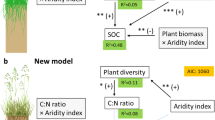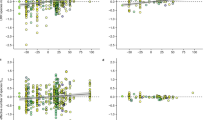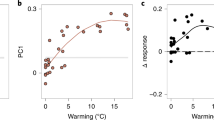Abstract
Extreme weather events are occurring more frequently, and research has shown that plant diversity can help mitigate the impacts of climate change by increasing plant productivity and ecosystem stability. Although soil temperature and its stability are key determinants of essential ecosystem processes, no study has yet investigated whether plant diversity buffers soil temperature fluctuations over long-term community development. Here we have conducted a comprehensive analysis of a continuous 18-year dataset from a grassland biodiversity experiment with high spatial and temporal resolutions. Our findings reveal that plant diversity acts as a natural buffer, preventing soil heating in hot weather and cooling in cold weather. This diversity effect persists year-round, intensifying with the aging of experimental communities and being even stronger under extreme climate conditions, such as hot days or dry years. Using structural equation modelling, we found that plant diversity stabilizes soil temperature by increasing soil organic carbon concentrations and, to a lesser extent, plant leaf area index. Our results suggest that, in lowland grasslands, the diversity-induced stabilization of soil temperature may help to mitigate the negative effects of extreme climatic events such as soil carbon decomposition, thus slowing global warming.
This is a preview of subscription content, access via your institution
Access options
Access Nature and 54 other Nature Portfolio journals
Get Nature+, our best-value online-access subscription
$29.99 / 30 days
cancel any time
Subscribe to this journal
Receive 12 print issues and online access
$259.00 per year
only $21.58 per issue
Buy this article
- Purchase on Springer Link
- Instant access to full article PDF
Prices may be subject to local taxes which are calculated during checkout




Similar content being viewed by others
Data availability
The data supporting the results of this study are publicly available in the Jena Experiment Information System (https://doi.org/10.25829/F1PZ-Q045)55.
Code availability
The code supporting the results of this study is deposited in the Jena Experiment Information System (https://doi.org/10.25829/F1PZ-Q045).
References
Rahmstorf, S. & Coumou, D. Increase of extreme events in a warming world. Proc. Natl Acad. Sci. USA 108, 17905–17909 (2011).
Zhang, Y., Chen, W., Smith, S. L., Riseborough, D. W. & Cihlar, J. Soil temperature in Canada during the twentieth century: complex responses to atmospheric climate change. J. Geophys. Res. Atmospheres 110, D03112 (2005).
Pregitzer, K. S. & King, J. S. in Nutrient Acquisition by Plants: An Ecological Perspective (ed. BassiriRad, H.) 277–310 (Springer, 2005).
Luo, H., Xu, H., Chu, C., He, F. & Fang, S. High temperature can change root system architecture and intensify root interactions of plant seedlings. Front. Plant Sci. 11, 160 (2020).
Soong, J. L. et al. Five years of whole-soil warming led to loss of subsoil carbon stocks and increased CO2 efflux. Sci. Adv. 7, eabd1343 (2021).
Achury, R. et al. Plant diversity and functional identity alter ant occurrence and activity in experimental grasslands. Ecosphere 13, e4252 (2022).
Pivonia, S., Cohen, R., Kigel, J. & Katan, J. Effect of soil temperature on disease development in melon plants infected by Monosporascus cannonballus. Plant Pathol. 51, 472–479 (2002).
Onwuka, B. M. Effects of soil temperature on some soil properties and plant growth. Adv. Plants Agric. Res. 8, 34–37 (2018).
Nievola, C. C., Carvalho, C. P., Carvalho, V. & Rodrigues, E. Rapid responses of plants to temperature changes. Temp. Multidiscip. Biomed. J. 4, 371–405 (2017).
De Frenne, P. et al. Global buffering of temperatures under forest canopies. Nat. Ecol. Evol. 3, 744–749 (2019).
De Frenne, P. et al. Forest microclimates and climate change: importance, drivers and future research agenda. Glob. Change Biol. 27, 2279–2297 (2021).
Zellweger, F. et al. Forest microclimate dynamics drive plant responses to warming. Science 368, 772–775 (2020).
Gillerot, L. et al. Forest structure and composition alleviate human thermal stress. Glob. Change Biol. 28, 7340–7352 (2022).
Isbell, F. et al. Biodiversity increases the resistance of ecosystem productivity to climate extremes. Nature 526, 574–577 (2015).
Wagg, C. et al. Biodiversity–stability relationships strengthen over time in a long-term grassland experiment. Nat. Commun. 13, 7752 (2022).
Tilman, D., Reich, P. B. & Knops, J. M. H. Biodiversity and ecosystem stability in a decade-long grassland experiment. Nature 441, 629–632 (2006).
Borer, E. T., Seabloom, E. W. & Tilman, D. Plant diversity controls arthropod biomass and temporal stability. Ecol. Lett. 15, 1457–1464 (2012).
Proulx, R. et al. Diversity promotes temporal stability across levels of ecosystem organization in experimental grasslands. PLoS ONE 5, e13382 (2010).
Eisenhauer, N. et al. Impact of above- and below-ground invertebrates on temporal and spatial stability of grassland of different diversity. J. Ecol. 99, 572–582 (2011).
Bond-Lamberty, B. & Thomson, A. Temperature-associated increases in the global soil respiration record. Nature 464, 579–582 (2010).
Spehn, E. M., Joshi, J., Schmid, B., Diemer, M. & Christian, K. Above-ground resource use increases with plant species richness in experimental grassland ecosystems. Funct. Ecol. 14, 326–337 (2000).
Zhang, S., Landuyt, D., Verheyen, K. & De Frenne, P. Tree species mixing can amplify microclimate offsets in young forest plantations. J. Appl. Ecol. 59, 1428–1439 (2022).
Guimarães-Steinicke, C. et al. Biodiversity facets affect community surface temperature via 3D canopy structure in grassland communities. J. Ecol. 109, 1969–1985 (2021).
Spehn, E. M., Joshi, J., Schmid, B., Alphei, J. & Körner, C. Plant diversity effects on soil heterotrophic activity in experimental grassland ecosystems. Plant Soil 224, 217–230 (2000).
Weisser, W. W. et al. Biodiversity effects on ecosystem functioning in a 15-year grassland experiment: patterns, mechanisms and open questions. Basic Appl. Ecol. 23, 1–73 (2017).
Weigel, R. et al. Ecosystem processes show uniform sensitivity to winter soil temperature change across a gradient from central to cold marginal stands of a major temperate forest tree. Ecosystems 24, 1545–1560 (2021).
Schimel, J. P., Bilbrough, C. & Welker, J. M. Increased snow depth affects microbial activity and nitrogen mineralization in two Arctic tundra communities. Soil Biol. Biochem. 36, 217–227 (2004).
Lembrechts, J. J. et al. Global maps of soil temperature. Glob. Change Biol. 28, 3110–3144 (2022).
Crowther, T. W. et al. Quantifying global soil carbon losses in response to warming. Nature 540, 104–108 (2016).
Melillo, J. M. et al. Long-term pattern and magnitude of soil carbon feedback to the climate system in a warming world. Science 358, 101–105 (2017).
Reich, P. B. et al. Impacts of biodiversity loss escalate through time as redundancy fades. Science 336, 589–592 (2012).
Ravenek, J. M. et al. Long-term study of root biomass in a biodiversity experiment reveals shifts in diversity effects over time. Oikos 123, 1528–1536 (2014).
Huang, Y. et al. Impacts of species richness on productivity in a large-scale subtropical forest experiment. Science 362, 80–83 (2018).
Vicente-Serrano, S. M., Beguería, S. & López-Moreno, J. I. A multiscalar drought index sensitive to global warming: the standardized precipitation evapotranspiration index. J. Clim. 23, 1696–1718 (2010).
García-Palacios, P., Gross, N., Gaitán, J. & Maestre, F. T. Climate mediates the biodiversity-ecosystem stability relationship globally. Proc. Natl Acad. Sci. USA 115, 8400–8405 (2018).
Zhu, D. et al. Controls of soil organic matter on soil thermal dynamics in the northern high latitudes. Nat. Commun. 10, 3172 (2019).
Horton, R. in Methods of Soil Analysis (eds Dane, J. H. & Topp, G. C.) 1227–1232 (Wiley, 2002).
Lange, M., Eisenhauer, N., Chen, H. & Gleixner, G. Increased soil carbon storage through plant diversity strengthens with time and extends into the subsoil. Glob. Change Biol. 29, 2627–2639 (2023).
Roscher, C. et al. The role of biodiversity for element cycling and trophic interactions: an experimental approach in a grassland community. Basic Appl. Ecol. 5, 107–121 (2004).
Roscher, C. et al. What happens to the sown species if a biodiversity experiment is not weeded? Basic Appl. Ecol. 14, 187–198 (2013).
Pfisterer, A. B., Joshi, J., Schmid, B. & Fischer, M. Rapid decay of diversity-productivity relationships after invasion of experimental plant communities. Basic Appl. Ecol. 5, 5–14 (2004).
Huang, Y., Kolle, O., Ebeling, A. & Eisenhauer, N. Climate data (daily resolution) from the climate station in The Jena Experiment from 2003 to 2022. Jena Experiment Information System https://doi.org/10.25829/NCPM-S988 (2023).
Cardinale, B. J. et al. The functional role of producer diversity in ecosystems. Am. J. Bot. 98, 572–592 (2011).
Huang, Y., Kolle, O., Kübler, K., Ebeling, A. & Eisenhauer, N. Standardized Precipitation-Evapotranspiration Index (SPEI) in the Jena Experiment from 2003 to 2021. Jena Experiment Information System https://doi.org/10.25829/D81J-F580 (2023).
Beguería, S., Vicente-Serrano, S. M., Reig, F. & Latorre, B. Standardized precipitation evapotranspiration index (SPEI) revisited: parameter fitting, evapotranspiration models, tools, datasets and drought monitoring. Int. J. Climatol. 34, 3001–3023 (2014).
Allen, R., Pereira, L. & Smith, M. Crop Evapotranspiration-Guidelines for Computing Crop Water Requirements-FAO Irrigation and Drainage Paper 56, Vol. 56 (Food and Agriculture Organization of the United Nations, 1998).
Huang, Y. et al. Community leaf area index (LAI) in the Main Experiment from 2003 to 2020. Jena Experiment Information System https://jexis.idiv.de/ddm/data/Showdata/154 (2023).
Fischer, C. et al. Plant species richness and functional groups have different effects on soil water content in a decade-long grassland experiment. J. Ecol. 107, 127–141 (2019).
Eisenhauer, N. et al. Plant diversity effects on soil microorganisms support the singular hypothesis. Ecology 91, 485–496 (2010).
Scheu, S. Automated measurement of the respiratory response of soil microcompartments: active microbial biomass in earthworm faeces. Soil Biol. Biochem. 24, 1113–1118 (1992).
Lange, M. et al. Plant diversity increases soil microbial activity and soil carbon storage. Nat. Commun. 6, 6707 (2015).
Zuur, A. F., Saveliev, A. A. & Ieno, E. N. in Beginner’s Guide to Spatial, Temporal and Spatial-Temporal Ecological Data Analysis with R-INLA, Volume 1 Using GLM and GLMM 267–299 (Highland Statistics Ltd, 2017).
Ochsner, T. E., Horton, R. & Ren, T. A new perspective on soil thermal properties. Soil Sci. Soc. Am. J. 65, 1641–1647 (2001).
Lefcheck, J. S. piecewiseSEM: piecewise structural equation modelling in R for ecology, evolution and systematics. Methods Ecol. Evol. 7, 573–579 (2016).
Huang, Y. et al. Data and R code used in: enhanced stability of grassland soil temperature by plant diversity. Jena Experiment Information System https://doi.org/10.25829/F1PZ-Q045 (2023).
Acknowledgements
We express our gratitude to the fieldworkers of the Jena Experiment. We thank the technical staff S. Eismann, G. Kratzsch, U. Köber, K. Kunze and H. Scheffler for their work in maintaining the field site and the many student helpers for weeding the experimental plots and assisting with the measurements. We also thank J. Hines for providing valuable data-analysis suggestions. Special thanks go to G. Rada (iDiv) for her exceptional artistic contribution to the illustration of Fig. 4. We would also like to thank the source of the image ‘Soil with roots’ from V. Romanov/stock.adobe.com, which was skilfully incorporated into the illustration. The Jena Experiment is funded by the German Research Foundation (DFG, FOR 5000). We gratefully acknowledge the support of iDiv, which is funded by the German Research Foundation (DFG – FZT 118, 202548816). M.S. is supported by the German Research Foundation (DFG, SH 1682/1-1). N.E. is also funded by the German Research Foundation (DFG, EI 862/29-1).
Author information
Authors and Affiliations
Contributions
E.-D.S., O.K. and K.K. installed and maintained the soil temperature measurement system. N.E. sourced the funding. Y.H. conceived the project. Y.H., G.S. and H.D. cleaned and analysed the data. D.E. made substantial contributions to time-series analysis using a Bayesian approach, while N.E., B.S., H.S., A.E., J.D. and M.S. provided valuable insights and ideas for methodology development and data analysis. Y.H. and G.S. wrote the first draft of the paper. A.E. is the scientific coordinator of the Jena Experiment. G.G., A.H., M.L., C.R., B.S., A.W. and W.W.W. originally created the dataset of the covariate variables. All authors contributed to the development of the ideas, discussed the analysis and results, and edited the paper text.
Corresponding author
Ethics declarations
Competing interests
The authors declare no competing interests.
Peer review
Peer review information
Nature Geoscience thanks Pieter De Frenne and the other, anonymous, reviewer(s) for their contribution to the peer review of this work. Primary Handling Editor: Xujia Jiang, in collaboration with the Nature Geoscience team.
Additional information
Publisher’s note Springer Nature remains neutral with regard to jurisdictional claims in published maps and institutional affiliations.
Extended data
Extended Data Fig. 1 Temperature time series at different heights and soil depths.
Data are from plots in block 2.
Extended Data Fig. 2 Air temperature at 2 m (a), precipitation (b), soil temperature at 8 cm (c), and drought index (SPEI) (d) change with time at the field site of the Jena Experiment.
In panels a and c, the lines represent predictions derived from simple linear regression models, with the shaded bands denoting the corresponding 95% confidence intervals (n = 18).
Extended Data Fig. 3 Experiment design (a) and photos of cable boxes and the temperature sensor in the plot (b, c).
a, Plots are arranged in four blocks following the randomized block design. Each plot has an area of 20 × 20 m. Different colours represent different levels of the sown plant diversity. Notably, two monoculture plots marked with a cross in panel a were excluded from our study in 2009 due to insufficient coverage of the target species. b, A photo showing the cable box in each plot for the soil temperature sensors. c, Soil temperature sensors at three different layers (5, 15, 60 cm) in block 2. In other three blocks, only the first two layers (5 and 15 cm) were measured. Photo credit: Karl Kübler.
Extended Data Fig. 4 Extreme climate days in plant communities with different plant diversity levels in each year.
Colour gradient represents the sown plant species richness from 0 to 60. The circles represent the corresponding data points. The mean number of heat days (maximum soil temperature at 5 cm is higher than 25 °C) and standard error (n = 14, 16 or 4) are shown in panel a. The mean number of freezing days (minimum soil temperature at 5 cm is lower than 0 °C) and standard error (n = 14, 16, or 4) are shown in panel b. Note that in 2013, summer data (June, July and August) is missing due to the flood.
Extended Data Fig. 5 Linear relationship between air temperature and the effects of plant diversity on daily soil temperature offset at 5 cm during days without snow cover (a) and the effects of snow cover depth on the plant diversity effects (b).
Here, plant diversity is depicted by sown plant species richness. a, Different colours represent different seasons. The lines were predicted from linear models (n = 6095). b, The black linear line and grey band representing the 95% confidence intervals are predicted from a linear mixed-effects model with the year, the months within year, and the autocorrelation of the plant diversity effects between days within year as random terms (n = 190). The symbols F and P in panel b represent the F-ratios and the corresponding P value, respectively, derived from the ANOVA table of linear mixed-effects models. The degrees of freedom for both the numerator and denominator are given in the subscript of the F value.
Extended Data Fig. 6 Nonlinear evolution of plant diversity effects over time.
Multiple nonlinear models were examined, with the logarithmic curve demonstrating the best fit. The linear year was logarithmically transformed, followed by a straightforward linear regression analysis to assess the influence of the transformed year on the effects of plant diversity on soil temperature annual stability. The depicted nonlinear curve and 95% confidence intervals band represents the model’s prediction after backtransformation of the independent variable year (n = 18).
Supplementary information
Supplementary Information
Supplementary Appendices 1 and 2, Figs. 1–13 and Tables 1–3.
Rights and permissions
Springer Nature or its licensor (e.g. a society or other partner) holds exclusive rights to this article under a publishing agreement with the author(s) or other rightsholder(s); author self-archiving of the accepted manuscript version of this article is solely governed by the terms of such publishing agreement and applicable law.
About this article
Cite this article
Huang, Y., Stein, G., Kolle, O. et al. Enhanced stability of grassland soil temperature by plant diversity. Nat. Geosci. 17, 44–50 (2024). https://doi.org/10.1038/s41561-023-01338-5
Received:
Accepted:
Published:
Issue Date:
DOI: https://doi.org/10.1038/s41561-023-01338-5



